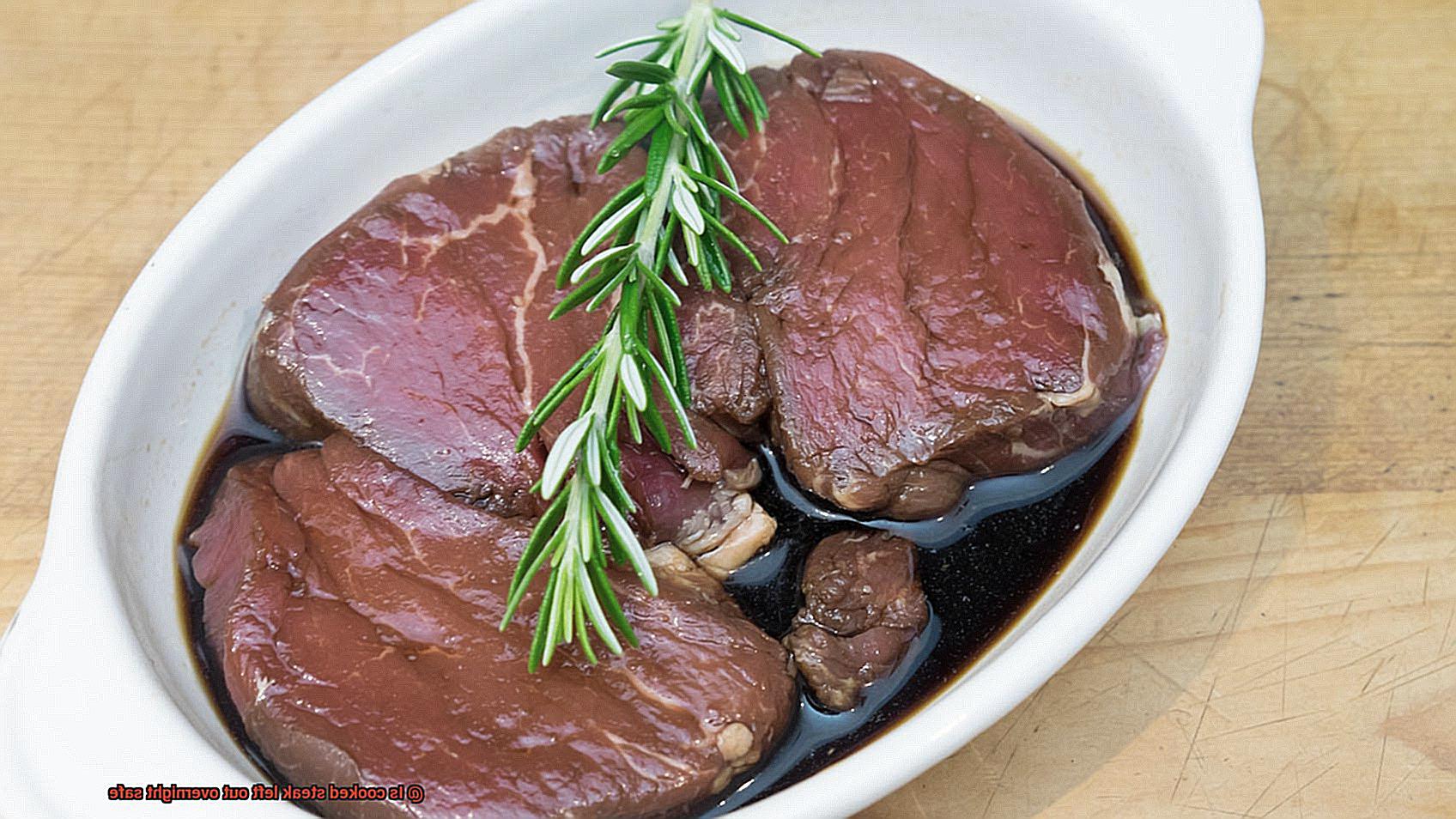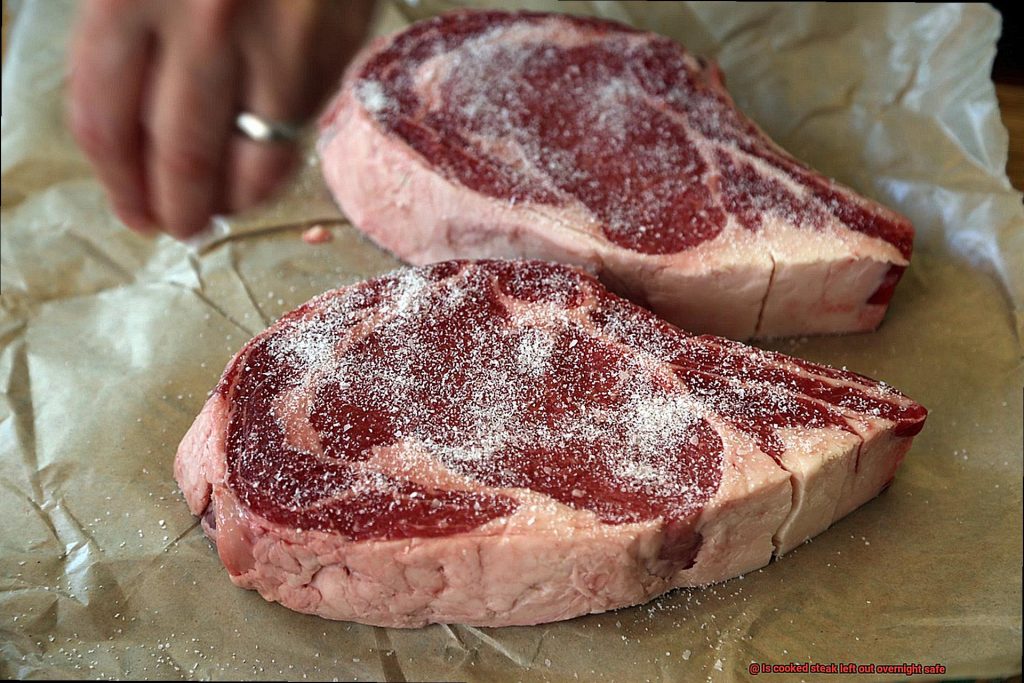Do you fancy grilling a juicy steak for dinner and savoring the leftovers the next day? Hold on, it’s time to pay heed to food safety protocols. Many believe that cooked steak left out overnight is safe to consume. But is it really?
The answer is a resounding no. Cooked steak left at room temperature for over two hours can be a breeding ground for bacteria growth, leading to food poisoning. The United States Department of Agriculture recommends that any perishable food, including beef, should not be left at room temperature for more than two hours.
But what are the risks involved in consuming a steak that has been left out overnight? In this blog post, we’ll delve deeper into the dangers of eating cooked steak at room temperature, signs of spoiled meat, and tips to store cooked steak safely.
Don’t let your love for steak compromise your health. Keep reading to learn more about proper food safety practices and how to avoid falling prey to foodborne illnesses.
Contents
What is the Risk of Eating Cooked Steak Left Out Overnight?
Unfortunately, the answer is a resounding no. The risks associated with consuming cooked steak left out overnight are significant and potentially dangerous.
One of the most significant risks is the growth of harmful bacteria, such as E. coli and salmonella. These microorganisms thrive in warm temperatures and can turn your once mouth-watering steak into a breeding ground for foodborne illness. Even if you’re confident that your steak was adequately heated before serving, leaving it out overnight can create a dangerous situation.
Furthermore, if the steak has been sitting in a moist environment, such as on a plate covered with foil or plastic wrap, the risk of bacterial growth increases. The combination of warmth and moisture creates an optimal environment for harmful bacteria to multiply rapidly.
But that’s not all – eating cooked steak left out overnight also increases the risk of spoilage. Exposure to air and moisture can cause the meat to spoil, leading to unpleasant symptoms such as gastrointestinal distress.

It’s important to note that this risk isn’t limited to beef; any cooked meat or poultry left out at room temperature for an extended period poses a risk of bacterial growth and spoilage.
To minimize these risks and ensure your safety when handling cooked meats, it’s essential to follow proper food safety practices. This includes refrigerating leftovers promptly (within two hours of cooking) and reheating them to the proper temperature before consuming.
Here are a few more tips to keep in mind:
- If the ambient temperature is above 90°F (32°C), then the meat should be refrigerated or frozen within one hour of cooking.
- Cooked steak should be stored in an airtight container or wrapped tightly in aluminum foil or plastic wrap to prevent exposure to air and contamination from other foods.
How Bacteria Can Grow on Cooked Steak Left Out Overnight
It may seem like a harmless shortcut, but it can lead to serious health risks. As an expert on the topic, let me explain why bacteria growth on cooked steak left out overnight is a real concern.
To begin with, let’s talk about the main culprit: Clostridium perfringens, a type of bacteria commonly found in meat. When meat is cooked, most bacteria on its surface are killed, but not all of them. Leaving cooked steak out at room temperature provides the perfect environment for any remaining bacteria to multiply rapidly and reach dangerous levels.
Why does this happen? Bacteria love warm temperatures and thrive in environments where moisture and food are readily available. Leaving cooked steak out overnight creates the ideal breeding ground for bacteria to multiply quickly and cause food poisoning if consumed.
To avoid this, it’s essential to follow proper food safety practices. Perishable foods should not be left out at room temperature for more than two hours. If the room temperature is above 90°F (32°C), perishable foods should not be left out for more than one hour. Remember that warmer temperatures increase the risk of bacterial growth.
Moreover, it’s crucial to store your leftover steak properly. If it’s left uncovered or stored in a container with an inadequate seal, it can attract more bacteria from the surrounding environment. To prevent this, store your leftover steak in an airtight container and refrigerate it promptly.
The US Department of Agriculture Guidelines for Storing Cooked Steak
As a food safety expert, I have delved into the US Department of Agriculture (USDA) guidelines for storing cooked steak and I am thrilled to share my insights with you.
The USDA emphasizes that cooked steak should not be left out at room temperature for more than two hours. Bacteria can quickly multiply on cooked meat that is left out in the open, which can lead to unwanted health complications. Therefore, if you have any leftover steak, it is crucial to store it promptly in the refrigerator within two hours of cooking.
It is recommended to store leftover steak in an airtight container or wrap it tightly in aluminum foil or plastic wrap. By doing so, you can prevent air from getting in and causing your steak to spoil faster. You can safely store leftover steak in the refrigerator for up to four days.
Reheating your leftover steak requires careful attention as well. It is vital to raise the internal temperature of the steak to 165°F to ensure any bacteria that may have grown are eliminated. You can use a microwave or oven to reheat your steak, but make sure it reaches the recommended temperature.
Avoid reheating your steak in a slow cooker or warming tray as these methods may not heat the meat evenly, leading to potential bacterial growth and posing a risk to your health. It’s essential to heat the meat uniformly to eliminate all harmful bacteria.
Refrigerating or Freezing Cooked Steak Within Two Hours of Cooking
Before you take a bite, let’s talk about the importance of refrigerating or freezing your cooked steak within two hours of cooking. As an expert in food safety, I can tell you that leaving cooked steak at room temperature for more than two hours can be a recipe for disaster. Harmful bacteria such as salmonella and E. coli can grow and multiply rapidly in warm or humid environments, putting your health at risk.
To prevent this from happening, it is recommended that you refrigerate or freeze your cooked steak within two hours of cooking. You should place your steak in a shallow container and cover it with a lid or plastic wrap before storing it in the fridge or freezer. This will keep it safe from any contamination from other foods in your fridge or freezer.
When it comes to storage times, there are a few things to keep in mind. If you’re refrigerating your steak, make sure to consume it within three to four days of cooking. If you’re planning to freeze your steak, it can be stored for up to six months. However, keep in mind that freezing can affect the texture and quality of your steak, so it may not taste as good as when freshly cooked.
If you want to reheat your cooked steak, ensure that it reaches a temperature of at least 165°F (74°C) to kill any bacteria that may have grown during storage. You can use a meat thermometer and heat your steak in an oven, microwave, or on a stovetop.
In summary, refrigerating or freezing cooked steak within two hours of cooking is essential for preventing bacteria growth and ensuring that your steak remains safe to eat. Here are some quick tips to help you remember:
- Refrigerate or freeze cooked steak within two hours of cooking.
- Store your steak in a shallow container with a lid or plastic wrap.
- Consume refrigerated steak within three to four days of cooking.
- Freeze steak for up to six months.
- Reheat your steak to a temperature of at least 165°F (74°C) before consuming.
Storing Cooked Steak in an Airtight Container or Wrapping It Tightly
When it comes to storing cooked steak, the choices can be overwhelming. Do you opt for an airtight container or wrap it tightly in foil or plastic wrap? As an expert on the matter, let me guide you through the advantages and disadvantages of each option.
If you choose to store your cooked steak in an airtight container, you can rest assured that it will stay fresh for longer. The seal on the container protects the steak from coming into contact with air. This not only prevents it from drying out, but also keeps any odors or flavors from other foods in the fridge from being absorbed by the steak. However, bear in mind that an airtight container alone cannot guarantee food safety. If the steak wasn’t cooled down properly before being stored, bacteria can still grow and spoil your meal. To avoid this, cool the steak to room temperature before storing it in an airtight container and place it in the fridge within two hours of cooking.
On the other hand, if you choose to wrap your cooked steak tightly in foil or plastic wrap, you’re creating a protective barrier between the meat and the air. This slows down spoilage and preserves its texture and flavor. However, like with an airtight container, proper cooling is paramount. If you don’t allow the steak to cool down before wrapping it tightly, condensation can form inside the wrap and create a breeding ground for bacteria. To avoid this, cool cooked steak to room temperature before wrapping it tightly and placing it in the fridge within two hours of cooking.
To summarize, both options are effective for storing cooked steak as long as proper cooling procedures are followed. The crucial factor here is food safety. Always prioritize food safety when storing any type of cooked meat to prevent foodborne illness.
Benefits of Following Food Safety Guidelines When Cooking and Storing Meats
If you want to indulge in delicious steaks, lip-smacking chicken, or mouth-watering pork, then it’s vital to understand the importance of following food safety guidelines when cooking and storing meats. As an expert in this area, I’m here to share some valuable information with you.
Firstly, let’s discuss the benefits of following food safety guidelines. By doing so, not only will you prevent harmful bacteria from growing in your meat, but you’ll also ensure it stays fresh and safe to eat for longer periods. This is particularly important for cooked meats that are left out overnight or for extended periods.
To delve deeper into the topic, here are some sub-topics and details on the benefits of following food safety guidelines:
- Preventing Foodborne Illnesses: Cooking meat to the correct internal temperature, refrigerating or freezing leftovers promptly, and storing meat at appropriate temperatures can significantly reduce the risk of food poisoning. This is essential to protect not only your health but also those around you who may consume the same food.
- Reducing Food Waste: Following proper guidelines and techniques can help extend the life of your meat and decrease the amount of waste that ends up in landfills.
- Maintaining Quality and Taste: Proper cooking and storage methods can help preserve the flavor and texture of the meat, ensuring a delightful meal every time.
Now let’s talk about why it’s crucial to follow these guidelines. When meat is not stored correctly or cooked to the proper temperature, harmful bacteria can grow rapidly. This can lead to unpleasant symptoms such as nausea, vomiting, diarrhea, and even hospitalization in severe cases. By adopting simple habits like washing hands before handling food, using separate cutting boards for raw meats and vegetables, and not leaving cooked meat out for too long, you can make a significant difference.
Common Illnesses Caused by Eating Contaminated Meat
Bacteria such as Salmonella, E. Coli, and Campylobacter are frequently found in contaminated meat, and can cause a range of symptoms from mild to severe.
Salmonella is often found in raw meat and poultry, and when not cooked properly or left at room temperature for too long, the bacteria can quickly multiply. Symptoms of Salmonella poisoning include diarrhea, fever, and abdominal cramps. In severe cases, the infection can even spread to the bloodstream, leading to more serious health issues.
E. Coli is another common bacteria found in undercooked or contaminated meat. This type of poisoning can be especially severe, with symptoms such as severe stomach cramps, bloody diarrhea, and vomiting. In some cases, E. Coli can even lead to kidney failure and death.
Campylobacter is typically found in raw or undercooked poultry but has been known to contaminate beef as well. Symptoms of Campylobacter poisoning are similar to those of Salmonella and E. Coli, including diarrhea (often bloody), fever, and abdominal cramps. In severe cases, dehydration and other complications may occur.
It’s important to keep in mind that there are other types of bacteria and viruses that can also be present in contaminated meat depending on how it was handled and stored.
To avoid getting sick from contaminated meat, proper handling and cooking are essential. Always wash your hands before and after handling raw meat, use separate cutting boards for meat and other foods, and cook meat to the proper internal temperature (usually 145°F for steak). If you’re uncertain about whether your cooked steak has been left out for too long or if it’s safe to eat, it’s best to discard it.
F19_WJMcgkQ” >
Conclusion
To sum it up, leaving cooked steak out overnight is a recipe for disaster. Bacteria love warm temperatures and moisture, and your once delicious steak can quickly turn into a breeding ground for harmful microbes like E. coli and salmonella. Not only that, but exposure to air and moisture can cause the meat to spoil, leading to unpleasant gastrointestinal symptoms.
To avoid these risks, you must always follow proper food safety practices. The USDA recommends refrigerating leftovers within two hours of cooking, and if the temperature is above 90°F (32°C), then within one hour. Additionally, reheating leftovers to the correct temperature before consuming them is crucial.
Proper storage is also essential in preventing contamination from other foods. Wrapping the steak tightly in aluminum foil or plastic wrap or storing it in an airtight container can help keep it fresh and safe to eat for longer periods. And remember to cool the steak down correctly before storing it.
By following these guidelines and adopting simple habits like washing hands before handling food, you can prevent harmful bacteria from growing and ensure that your meat stays fresh and safe to consume.






